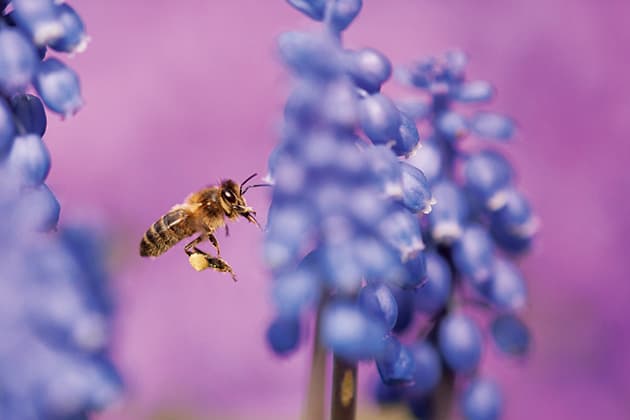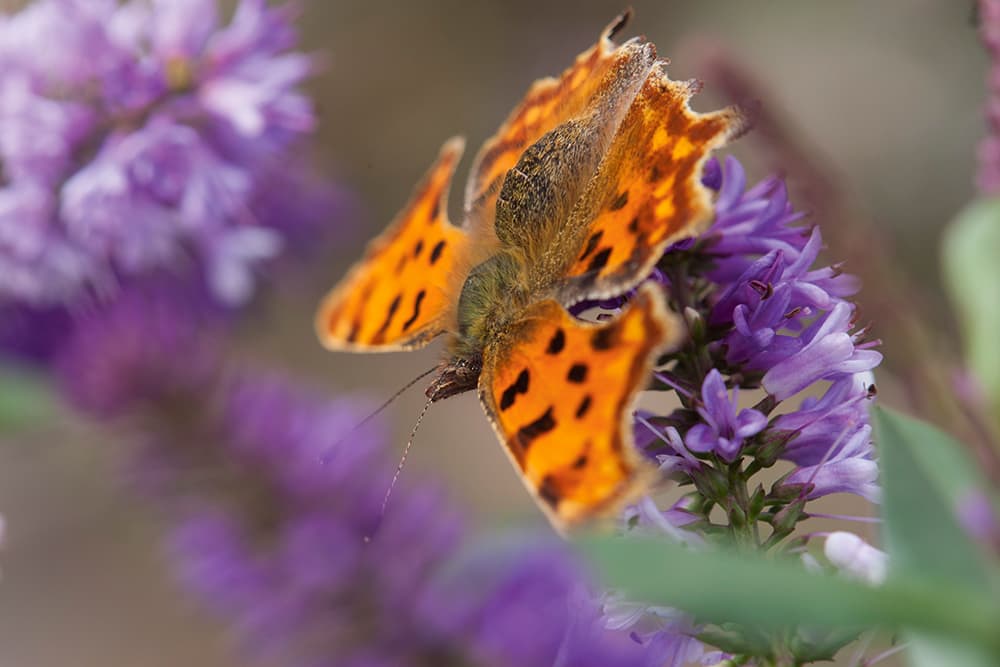
Planting nectar-rich bushes like buddleia are excellent for attracting butterflies such as the comma. All photos by Paul Hobson
Even the scruffiest gardens are the hidden nature reserves of Britain. They are vitally important for our wildlife and it’s not hard to plan and plant your garden to benefit both local wildlife as well as creating a superb outside studio for your photography.
A variety of species
When you add new plants you need to consider how they will benefit insects, birds and mammals. The best starting point is to add plants that provide a source of nectar and/or pollen throughout the year for bees, butterflies, moths and hoverflies. This means you will need a variety of species that will flower from spring through to autumn. Some species, like sunflowers, are annuals, so may need replanting each year. However, other species, like ivy and fruit trees, are perennials and live for years, so will need careful positioning. Many plants are multi-purpose and provide nectar and pollen-rich flowers for insects, leaves for caterpillars, as well as fruit and seeds later in the year for birds and mammals. Ivy and apple trees are classic examples.
The best way to start is with a plan of your garden on paper. Think where the sun is positioned throughout the year and remember that it changes over the seasons. The next thing is to consider where you will be doing your photography, so you can plan your backgrounds and think about what to plant in each position. To improve your backgrounds, contemplate using raised beds or even planting species in pots, which can be moved to a better position when you want to begin shooting.

By leaving old props around the garden many birds get used to them. It may be a bit hackneyed, but it’s still a popular image
Attracting wildlife
Planting species that provide food is a key consideration, but you also need to think about cover and structure. Birds will benefit greatly from bushes that provide nesting opportunities as well as cover to avoid the sparrowhawks that will no doubt try their luck around your bird feeders.
Adding food is a tried-and-tested way to attract birds to your garden. Hanging feeders with sunflower hearts and peanuts will attract tits and great spotted woodpeckers. Feeders with smaller holes containing niger seeds will draw in goldfinches, while thrushes and wood mice will be enticed by old apples. Don’t forget that many mammals are nocturnal – scattered chop bones or bits of chicken will hopefully lure your local fox. I sprinkle a couple of handfuls of peanuts out each evening because I am lucky enough to get the occasional visit from a badger. It also means I have a good population of wood mice in my garden.
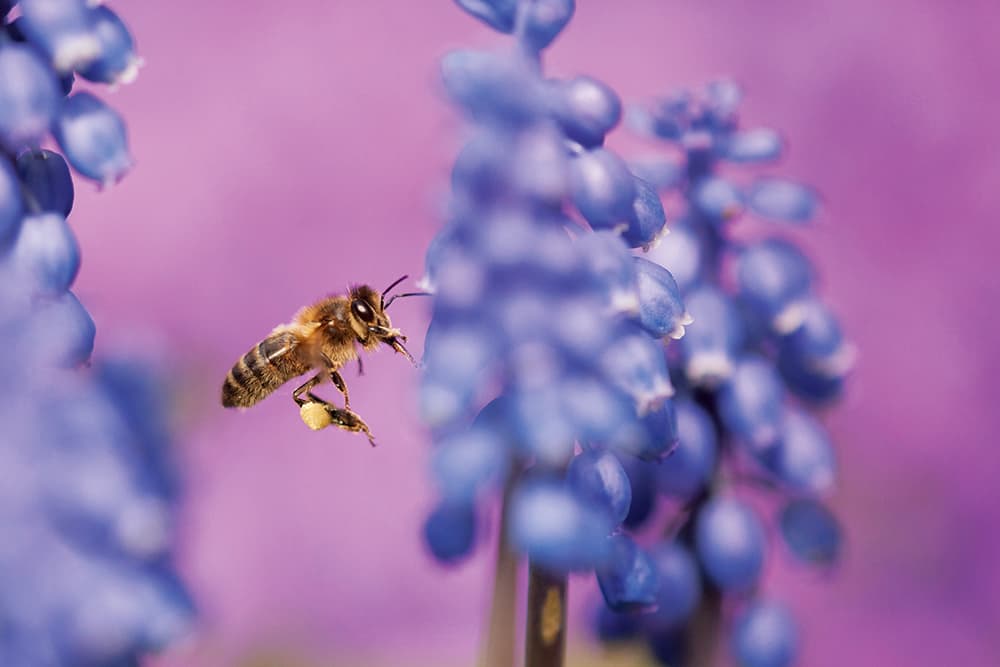
Grape hyacinths are a good small spring flower for bees
Trees and ponds
A vertical structure is considered very good for birds, so if you can add a tree or two this will be beneficial. Try to use native species like crab apple or birch, which are also food plants for many moth caterpillars. These help to provide food for small nesting birds like robins, and the moths will be very attractive to any bats that may pay your garden a visit.
Many wildlife enthusiasts think the single most important thing you can add to a garden is a pond. These don’t need to be giant ornamental affairs. A small plastic pond costs about £50 and can be sunk easily into one corner of a garden. Try to site it in good sunlight and think carefully about how you will use it for photography. A good tip is to keep the edges raised slightly above the level of the ground and use earth and plants to create a gradient rising to the edge. This means you can photograph across the water level and get nicer backgrounds. Add a clump of frog spawn and some weeds from a local pond and you will have hours of fun photographing the pond during the summer. If you keep a stone just below the surface in the shallow end you will get birds drinking from it regularly.
A few other simple tips will help to boost wildlife opportunities. Never use any chemicals, just live with the slugs and snails (which are brilliant subjects anyway); create a compost heap where you put all your vegetable kitchen waste and garden prunings; build or buy bird-nest boxes and bee homes; create a mini meadow (if you have the space) with British wildflowers; leave weedy corners, or even plant a few beneficial weeds like nettles (great for red admiral and peacock butterflies) and rosebay willowherb (good for elephant hawk-moths); have an area of sunny, bare earth for tawny mining bees, which you never dig, just weed occasionally; if you have any bare walls add a trellis and plant a cover plant like clematis, ivy or honeysuckle – this will provide cover for birds and is excellent insect food.
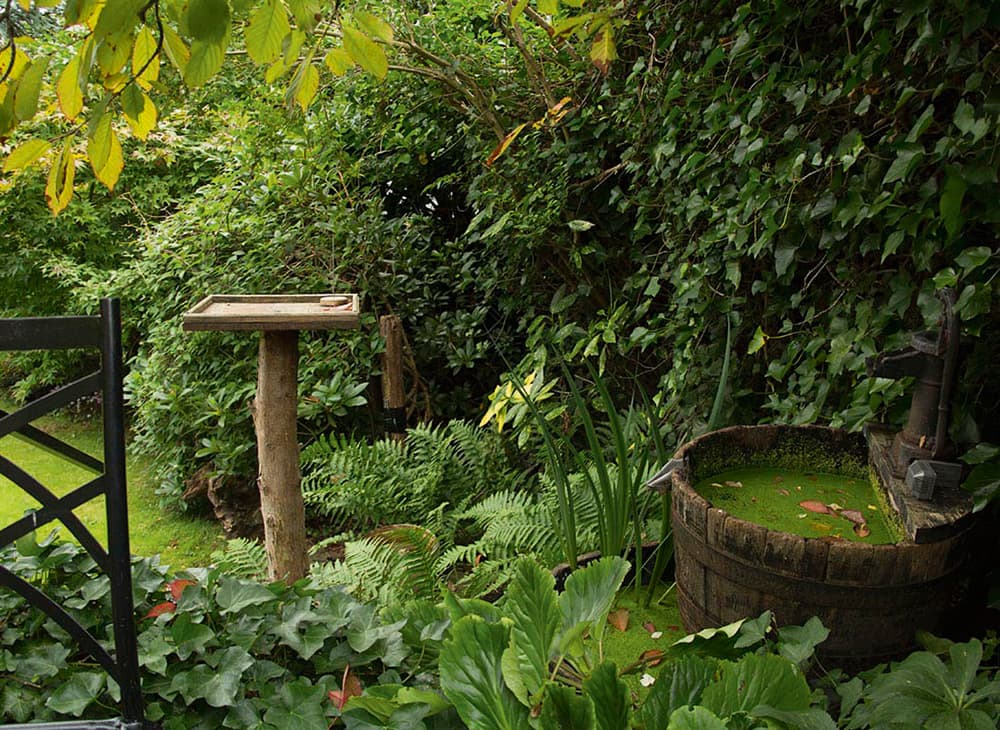
I chose this shady corner to plant ivy for holly blue butterflies. They need ivy and holly leaves during the year. It is also a great place for red admiral butterflies, wasps and hoverflies
Building a hide
Having your own hide can be a great way to shoot wildlife in your garden and there are a number of options, depending on how permanent you want the hide to be. If you only intend to photograph on the odd day, then a simple pop-up chair hide will suffice. Most garden birds won’t baulk at a new hide, so you can simply pop it up when you want to shoot. If you want a more permanent affair, think about building a small wooden hide out of timber and waterproof plywood.
An alternative is to buy a small shed and place this in your chosen position (think about background and direction of light). You can remove a window and replace it with scrim, or cut a hole into a wall for your lens. Another idea, which is really a halfway solution, is to make or buy a screen with a viewing hole and lens hole cut into it. If you are practically minded, you could even weave one yourself from willow shoots. When you site your hide try to get the background as far away as possible and avoid any plants with shiny leaves, like holly, which can create horrible hot spots in your images.
 Don’t miss a thing
Don’t miss a thing
Never overlook what might be thought mundane – small snails, zebra spiders and woodlice can be remarkable subjects, and a little creative thought and lighting can produce some really fantastic images. Practice always makes perfect, so when you have some spare time use your macro lens with a variety of light sources such as a torch or fill-flash on a common subject such as a woodlouse (never use full flash on insects, as it can damage their eyes). Perfect backlighting and front lighting, and play with your white balance to create warm, appealing images. This practice will mean that when you start to work on more skittish insects, you will be able to make quick, knowledgeable decisions to create the lighting effects you want. I was able to use the low sun at the end of the day as backlighting on this woodlouse and by deliberately underexposing I have tried to create a moody effect.
Easy access
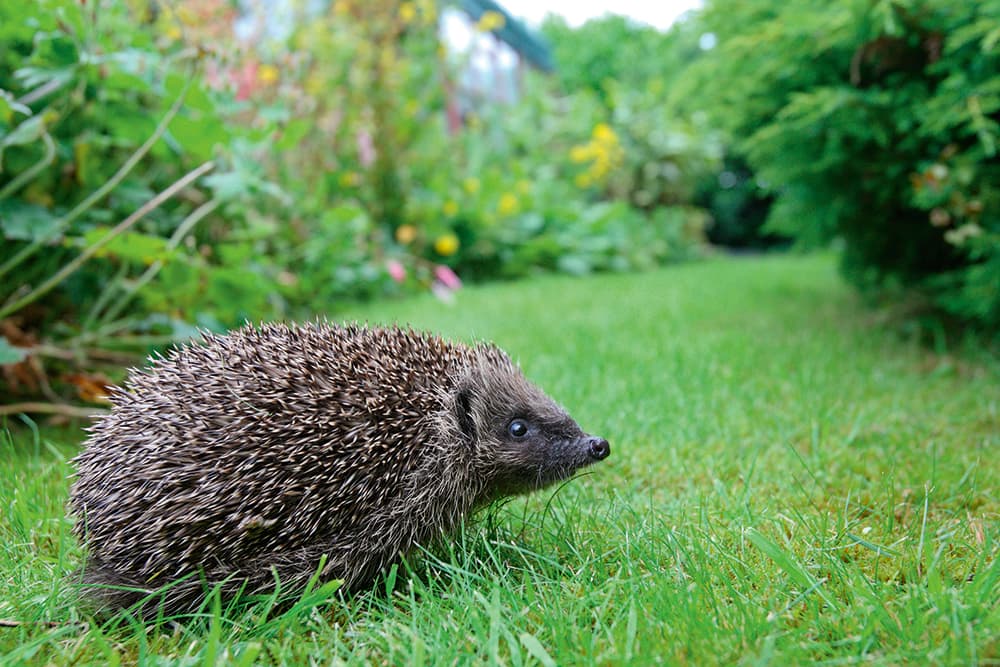
You may be lucky to have hedgehogs, foxes or badgers visiting your garden. They will also be foraging in a number of gardens around you. You need to make sure these animals have easy access, so if you have boxed-in your plot with fencing, cut a few holes in the bottom to allow them to move around freely.

After more than 20 years as an environmental-science lecturer, Paul Hobson packed it all in to move into wildlife photography full time. He loves travelling around the world, but definitely prefers working in the UK – the demands on the photographer are harder, but the rewards greater. www.paulhobson.co.uk

